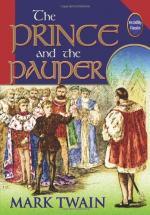A file of forty or fifty state barges drew up to the steps. They were richly gilt, and their lofty prows and sterns were elaborately carved. Some of them were decorated with banners and streamers; some with cloth-of-gold and arras embroidered with coats-of-arms; others with silken flags that had numberless little silver bells fastened to them, which shook out tiny showers of joyous music whenever the breezes fluttered them; others of yet higher pretensions, since they belonged to nobles in the prince’s immediate service, had their sides picturesquely fenced with shields gorgeously emblazoned with armorial bearings. Each state barge was towed by a tender. Besides the rowers, these tenders carried each a number of men-at-arms in glossy helmet and breastplate, and a company of musicians.
The advance-guard of the expected procession now appeared in the great gateway, a troop of halberdiers. ’They were dressed in striped hose of black and tawny, velvet caps graced at the sides with silver roses, and doublets of murrey and blue cloth, embroidered on the front and back with the three feathers, the prince’s blazon, woven in gold. Their halberd staves were covered with crimson velvet, fastened with gilt nails, and ornamented with gold tassels. Filing off on the right and left, they formed two long lines, extending from the gateway of the palace to the water’s edge. A thick rayed cloth or carpet was then unfolded, and laid down between them by attendants in the gold-and-crimson liveries of the prince. This done, a flourish of trumpets resounded from within. A lively prelude arose from the musicians on the water; and two ushers with white wands marched with a slow and stately pace from the portal. They were followed by an officer bearing the civic mace, after whom came another carrying the city’s sword; then several sergeants of the city guard, in their full accoutrements, and with badges on their sleeves; then the Garter King-at-arms, in his tabard; then several Knights of the Bath, each with a white lace on his sleeve; then their esquires; then the judges, in their robes of scarlet and coifs; then the Lord High Chancellor of England, in a robe of scarlet, open before, and purfled with minever; then a deputation of aldermen, in their scarlet cloaks; and then the heads of the different civic companies, in their robes of state. Now came twelve French gentlemen, in splendid habiliments, consisting of pourpoints of white damask barred with gold, short mantles of crimson velvet lined with violet taffeta, and carnation coloured hauts-de-chausses, and took their way down the steps. They were of the suite of the French ambassador, and were followed by twelve cavaliers of the suite of the Spanish ambassador, clothed in black velvet, unrelieved by any ornament. Following these came several great English nobles with their attendants.’




